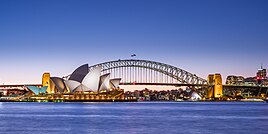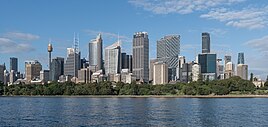
Back Сиднеи Abkhazian Sydney Afrikaans Sydney ALS ሲድኒ Amharic Sydney AN Sydney ANG سيدني Arabic ܣܝܕܢܝ ARC سيدني ARY سيدنى ARZ
| Sydney New South Wales | |||||||||
|---|---|---|---|---|---|---|---|---|---|
 Map of the Sydney metropolitan area | |||||||||
| Coordinates | 33°52′S 151°12′E / 33.867°S 151.200°E | ||||||||
| Population | 5,450,496 (2023)[1] (1st) | ||||||||
| • Density | 441/km2 (1,140/sq mi) (2023)[1] | ||||||||
| Established | 26 January 1788 | ||||||||
| Area | 12,367.7 km2 (4,775.2 sq mi)(GCCSA)[2] | ||||||||
| Time zone | AEST (UTC+10) | ||||||||
| • Summer (DST) | AEDT (UTC+11) | ||||||||
| Location | |||||||||
| LGA(s) | Various (33) | ||||||||
| County | Cumberland[3] | ||||||||
| State electorate(s) | Various (49) | ||||||||
| Federal division(s) | Various (24) | ||||||||
| |||||||||
Sydney is the capital city of the state of New South Wales and the most populous city in Australia. Located on Australia's east coast, the metropolis surrounds Sydney Harbour and extends about 80 km (50 mi) from the Pacific Ocean in the east to the Blue Mountains in the west, and about 80 km (50 mi) from the Ku-ring-gai Chase National Park and the Hawkesbury River in the north and north-west, to the Royal National Park and Macarthur in the south and south-west.[5] Greater Sydney consists of 658 suburbs, spread across 33 local government areas. Residents of the city are colloquially known as "Sydneysiders".[6] The estimated population in June 2023 was 5,450,496,[1] which is about 66% of the state's population.[7] The city's nicknames include the Emerald City and the Harbour City.[8]
Aboriginal Australians have inhabited the Greater Sydney region for at least 30,000 years, and their engravings and cultural sites are common. The traditional custodians of the land on which modern Sydney stands are the clans of the Darug, Dharawal and Eora peoples.[9] During his first Pacific voyage in 1770, James Cook charted the eastern coast of Australia, making landfall at Botany Bay. In 1788, the First Fleet of convicts, led by Arthur Phillip, founded Sydney as a British penal colony, the first European settlement in Australia.[10] After World War II, Sydney experienced mass migration and by 2021 over 40 per cent of the population was born overseas. Foreign countries of birth with the greatest representation are mainland China, India, the United Kingdom, Vietnam and the Philippines.[11]
Despite being one of the most expensive cities in the world,[12][13] Sydney frequently ranks in the top ten most liveable cities.[14][15][16] It is classified as an Alpha+ city by the Globalization and World Cities Research Network, indicating its influence in the region and throughout the world.[17][18] Ranked eleventh in the world for economic opportunity,[19] Sydney has an advanced market economy with strengths in education, finance, manufacturing and tourism.[20][21] The University of Sydney and the University of New South Wales are ranked 18th and 19th in the world respectively.[22]
Sydney has hosted major international sporting events such as the 2000 Summer Olympics, the 2003 Rugby World Cup Final, and the 2023 FIFA Women's World Cup Final. The city is among the top fifteen most-visited,[23] with millions of tourists coming each year to see the city's landmarks.[24] The city has over 1,000,000 ha (2,500,000 acres) of nature reserves and parks,[25] and its notable natural features include Sydney Harbour and Royal National Park. The Sydney Harbour Bridge and the World Heritage-listed Sydney Opera House are major tourist attractions. Central Station is the hub of Sydney's suburban train, metro and light rail networks and longer-distance services. The main passenger airport serving the city is Kingsford Smith Airport, one of the world's oldest continually operating airports.[26]
- ^ a b c "Regional Population – 2022–23 final". Australian Bureau of Statistics. Archived from the original on 30 March 2021. Retrieved 26 March 2024.
- ^ Cite error: The named reference
ABSGCCSAXLSwas invoked but never defined (see the help page). - ^ "Cumberland County". Geographical Names Register (GNR) of NSW. Geographical Names Board of New South Wales. Retrieved 20 September 2017.
- ^ a b c Cite error: The named reference
metdatawas invoked but never defined (see the help page). - ^ Mason, Herbert (2012). Encyclopaedia of Ships and Shipping. p. 266.
- ^ "Complete official list of Sydney suburbs". Walk Sydney Streets. 2014. Archived from the original on 25 November 2019. Retrieved 13 July 2014.
- ^ "3218.0 – Regional Population Growth, Australia, 2016–17: Main Features". Australian Bureau of Statistics. 24 April 2018. Archived from the original on 13 October 2018. Retrieved 13 October 2018. Estimated resident population, 30 June 2017.
- ^ Tom Smith (4 November 2017). "Why Sydney Is Also Known As 'The Emerald City'". Culture Trip. Archived from the original on 11 September 2021. Retrieved 11 September 2021.
- ^ Heiss, Anita; Gibson, Melodie-Jane (2013). "Aboriginal people and place". Sydney Barani. Archived from the original on 7 July 2014. Retrieved 5 July 2014.
- ^ "Manly Heritage & History". Manly Council. Archived from the original on 12 May 2016. Retrieved 10 May 2016.
- ^ Cite error: The named reference
autowas invoked but never defined (see the help page). - ^ Levy, Megan (5 March 2014). "Sydney, Melbourne more expensive than New York, says Living Index". The Sydney Morning Herald. Archived from the original on 1 July 2014. Retrieved 20 July 2014.
- ^ Bowman, Simon J.; Fisher, Benjamin (19 May 2022), "The Cost of Living with Sjögren's", The Sjögren's Book, Oxford University Press, pp. 26–30, doi:10.1093/oso/9780197502112.003.0005, ISBN 978-0-19-750211-2, archived from the original on 21 February 2024, retrieved 1 June 2023
- ^ "Sydney retains #10 ranking in Mercer's global quality of living survey". Mercer.com.au. 28 April 2018. Archived from the original on 28 April 2018. Retrieved 28 April 2018.
- ^ "World's most liveable cities: Vienna's win leaves Sydney and Melbourne in a spin". The Guardian. 4 September 2019. Archived from the original on 25 September 2019. Retrieved 26 September 2019.
- ^ "2018 Quality of Living Index". Mercer. 2018. Archived from the original on 16 April 2018. Retrieved 28 April 2018.
- ^ "The World According to GaWC 2020". GaWC – Research Network. Globalization and World Cities. Archived from the original on 6 October 2020. Retrieved 31 August 2020.
- ^ Global Power City Index 2010 (PDF) (Report). Tokyo, Japan: Institute for Urban Strategies at The Mori Memorial Foundation. October 2010. Archived (PDF) from the original on 20 October 2020. Retrieved 10 August 2011.
- ^ "Cities of opportunity" (PDF). PricewaterhouseCoopers. 2012. Archived from the original (PDF) on 10 February 2013. Retrieved 21 July 2014.
- ^ http://www.smh.com.au/national/tough-week-for-a-sydney-success-story-20120217-1te9q.html?skin=text-only [dead link]
- ^ Irvine, Jessica (2008). "Another shot at making city a finance hub". The Sydney Morning Herald. Archived from the original on 24 September 2015. Retrieved 26 July 2014.
- ^ "QS World University Rankings 2025". Top Universities. 18 October 2024. Retrieved 20 October 2024.
- ^ Dennis, Anthony (2013). ""Too expensive" Sydney slips from top 10 tourism list". The Sydney Morning Herald. Archived from the original on 25 September 2014. Retrieved 27 October 2016.
In this year's World's Best Awards, announced in New York this week, Sydney came in as the world's number 12 ranked best city.
- ^ "Our global city". City of Sydney. 2014. Archived from the original on 22 June 2014. Retrieved 21 July 2014.
- ^ Benson, D. H. and Howell J. (1990) Taken for Granted: the Bushland of Sydney and Its Suburbs, Sydney
- ^ "Overview". Sydney Airport. 2014. Archived from the original on 5 September 2014. Retrieved 10 August 2014.






